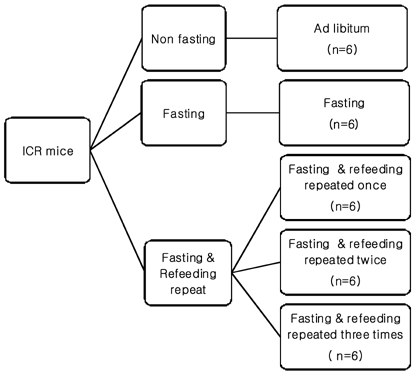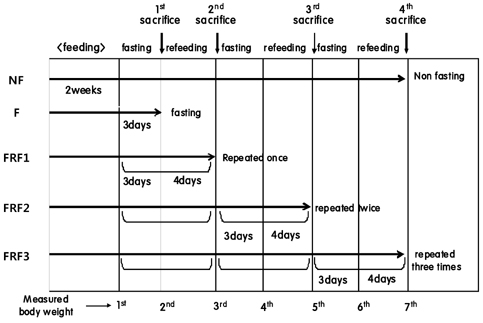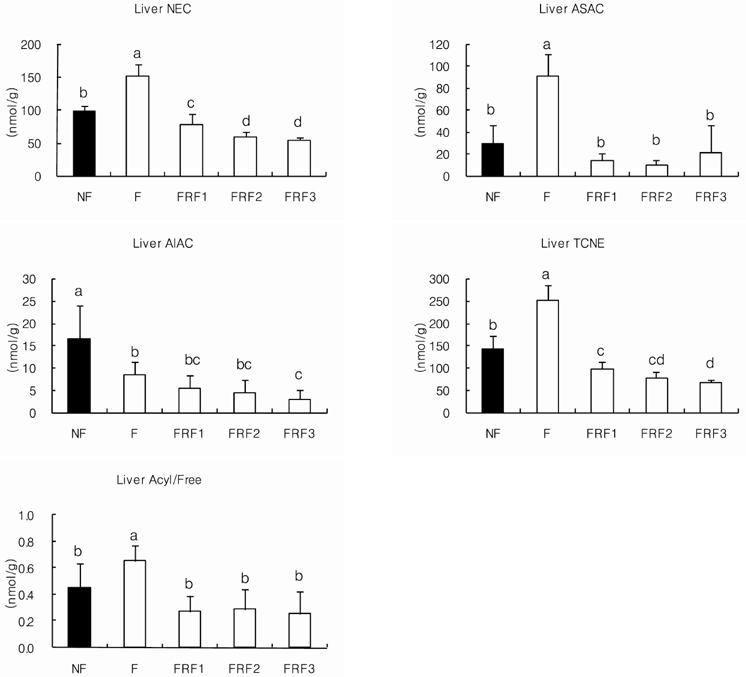Nutr Res Pract.
2010 Dec;4(6):477-485.
Changes in lipid and carnitine concentrations following repeated fasting-refeeding in mice
- Affiliations
-
- 1Department of Food Science and Human Nutrition, Research Institute of Human Ecology, Jeonbuk National University, 664-14 Dukjin-dong 1-ga, Jeonju, Jeonbuk 561-756, Korea. cha8@jbnu.ac.kr
Abstract
- The purpose of this study was to evaluate the effects of repeated fasting and refeeding on lipid metabolism. Thirty male ICR mice, aged 6 weeks, were fed an AIN-93 control diet during the experimental period. The mice were divided into 5 groups: Non fasting group (ad libitum-fed, NF), fasting for 3 days (F), fasting for 3 days and then refeeding for 4 days repeated once (FRF1), fasting for 3 days and then refeeding for 4 days repeated twice (FRF2), and fasting for 3 days and then refeeding for 4 days repeated three times (FRF3). Rates of body weight gain, epididymal fat weight, and serum TG were significantly decreased in the F, FRF1, FRF2, and FRF3 groups, compared to the NF group. LDL-cholesterol was significantly higher in the FRF3 group than the NF and F groups, but HDL-cholesterol and HDL/TC were significantly lower in the FRF3 group than in the NF and F groups. Serum total carnitine was significantly lower in the FRF1, FRF2, FRF3 groups than the NF and F groups. However, rates of serum and hepatic acyl-carnitine concentration were significantly lower in FRF1, FRF2, and FRF3 than in NF and F. Repeated fasting-refeeding resulted in visible reductions of body weight and fat mass, but it caused ill-effects with lipid and carnitine metabolism in the body.
Keyword
MeSH Terms
Figure
Reference
-
1. Heeb JL. Changes in the prevalence of overweight and obesity: some evidence from the Swiss Health Surveys 1992/93 and 2002. Eur J Public Health. 2009. [Epub ahead of print].
Article2. Houston DK, Nicklas BJ, Zizza CA. Weighty concerns: the growing prevalence of obesity among older adults. J Am Diet Assoc. 2009. 109:1886–1895.
Article3. Macfarlane DJ, Thomas GN. Exercise and diet in weight management: updating what works. Br J Sports Med. 2010. 44:1197–1201.
Article4. Booth ML, Wilkenfeld RL, Pagnini DL, Booth SL, King LA. Perceptions of adolescents on overweight and obesity: the weight of opinion study. J Paediatr Child Health. 2008. 44:248–252.
Article5. Richelsen B, Pedersen SB. Healthy obese subjects. Is weight loss treatment indicated? Ugeskr Laeger. 2009. 171:3092–3094.6. O'Hara L, Gregg J. The war on obesity: a social determinant of health. Health Promot J Austr. 2006. 17:260–263.7. Muchiteni T, Borden WB. Improving risk factor modification: a global approach. Curr Cardiol Rep. 2009. 11:476–483.
Article8. Ziaee V, Razaei M, Ahmadinejad Z, Shaikh H, Yousefi R, Yarmohammadi L, Bozorgi F, Behjati MJ. The changes of metabolic profile and weight during Ramadan fasting. Singapore Med J. 2006. 47:409–414.9. Goldbeter A. A model for the dynamics of human weight cycling. J Biosci. 2006. 31:129–136.
Article10. Sung JK. How to approach animal experiments? Short course. 1998. Seoul: The Korean Society of Gastroenterology;1–16.11. Friedewald WT, Levy RI, Fredrickson DS. Estimation of concentration of low density lipoprotein cholesterol in plasma, without use the prepatative ultracentrifuge. Clin Chem. 1972. 18:499–502.
Article12. Sachan DS, Rhew TH, Ruak RA. Ameliorating effects of carnitine and its precursors on alcohol-induced fatty liver. Am J Clin Nutr. 1984. 39:738–744.
Article13. Cederblad G, Lindstedt S. A method for the determination of carnitine in the picomole range. Clin Chim Acta. 1972. 37:235–243.
Article14. Lee CK, Kim YW. Changes of lipogenic and lipolytic activities following repeated fasting and refeeding in rat. Korean Journal of Obesity. 2005. 14:16–21.15. Jen KL, Lu H, Savona L, Watkins A, Shaw M. Long-term weight cycling reduces body weight and fat free mass, but not fat mass in female Wistar rats. Int J Obes Relat Metab Disord. 1995. 19:699–708.16. Kochan Z, Karbowska J, Swierczyński J. Unusual increase of lipogenesis in rat white adipose tissue after multiple cycles of starvation-refeeding. Metabolism. 1997. 46:10–17.
Article17. Kochan Z, Goyke E, Karbowska J, Slominska E, Swierczynski J. The decrease of rat postprandial plasma triacylglycerol concentration after multiple cycles of starvation-refeeding. Horm Metab Res. 2001. 33:26–29.
Article18. Horton JD, Bashmakov Y, Shimomura I, Shimano H. Regulation of sterol regulatory element binding proteins in livers of fasted and refed mice. Proc Natl Acad Sci U S A. 1998. 95:5987–5992.
Article19. Björntorp P, Yang MU, Greenwood MR. Refeeding after fasting in the rat: effects of carbohydrate. Am J Clin Nutr. 1983. 37:396–402.
Article20. Björntorp P, Edström S, Kral JG, Lundholm K, Presta E, Walks D, Yang MU. Refeeding after fasting in the rat: energy substrate fluxes and replenishment of energy stores. Am J Clin Nutr. 1982. 36:450–456.
Article21. Heber D. DeGroot LJ, editor. Endocrine response to fasting, malnutrition and illness. Endocrinology. 1995. 3rd ed. Philadelphia: WB Saunders.22. Kmiec Z, Pokrywka L, Kotlarz G, Kubasik J, Szutowicz A, Mysliwski A. Effects of fasting and refeeding on serum leptin, adiponectin and free fatty acid concentrations in young and old male rats. Gerontology. 2005. 51:357–362.
Article23. Ohama T, Matsuki N, Saito H, Tsukamoto K, Kinoshita M, Katsuragawa K, Okazaki S, Yamanaka M, Teramoto T. Effect of starving and refeeding on lipid metabolism in suncus. J Biochem. 1994. 115:190–193.24. Tepperman HM, Tepperman J. The hexosemonophosphate shunt and adaptive hyperlipogenesis. Diabetes. 1958. 7:478–485.
Article25. Niemeyer H, Gonzalez C, Rozzi R. Influence of diet on liver phosphorylase. Effect of fasting and refeeding. J Biol Chem. 1961. 236:610–613.26. McDonald BE, Johnson BC. Metabolic response to realimentation following chronic starvation in the adult male rat. J Nutr. 1965. 87:161–167.
Article27. Szepesi B, Freedland RA. Differential requirement for de novo RNA synthesis in the starved-refed rat; inhibition of the overshoot by 8-azaguanine after refeeding. J Nutr. 1969. 99:449–458.
Article28. Szepesi B, Berdanier CD. Time course of the starve-refeed response in rats: the possible role of insulin. J Nutr. 1971. 101:1563–1574.
Article29. Michaelis OE 4th, Szepesi B. Effect of various sugars on hepatic glucose-6-phosphate dehydrogenase malic enzymes and total lipid of the rat. J Nutr. 1973. 103:697–705.
Article30. Williams BH, Berdanier CD. Effects of diet composition and adrenalectomy on the lipogenic responses of rats to starvation-refeeding. J Nutr. 1982. 112:534–541.
Article31. Becker DJ, Pimstone BL, Hansen JD, Hendricks S. Insulin secretion in protein-calorie malnutrition I Quantitative abnormalities and response to treatment. Diabetes. 1971. 20:542–551.
Article32. Sävendahl L, Underwood LE. Decreased interleukin-2 production from cultured peripheral blood mononuclear cells in haman acute starvation. J Clin Endocrinol Metab. 1997. 82:1177–1180.
Article33. Sävendahl L, Underwood LE. Fasting increases serum total cholesterol, LDL cholesterol and apolipoprotein B in healthy, nonobese humans. J Nutr. 1999. 129:2005–2008.
Article34. Hoppel CL, Genuth SM. Carnitine metabolism in normal-weight and obese human subjects during fasting. Am J Physiol. 1980. 238:E409–E415.
Article35. Frohlich J, Seccombe DW, Hahn P, Dodek P, Hynie I. Effect of fasting on free and esterified carnitine levels in human serum and urine: correlation with serum levels of free fatty acids and beta-hydroxybutyrate. Metabolism. 1978. 27:555–561.
Article
- Full Text Links
- Actions
-
Cited
- CITED
-
- Close
- Share
- Similar articles
-
- The Effect of Food Restriction on Appetite Regulating Hormones and Adiponectin Activity
- Intravital Two-photon Imaging of Dynamic Alteration of Hepatic Lipid Droplets in Fasted and Refed State
- Changes of Lipogenic and Lipolytic Activities Following Repeated Fasting and Refeeding in Rat
- L-carnitine in maintenance hemodialysis clinical, lipid and biochemical effects
- Alterations in the carnitine metabolism in epileptic children treated with valproic acid









